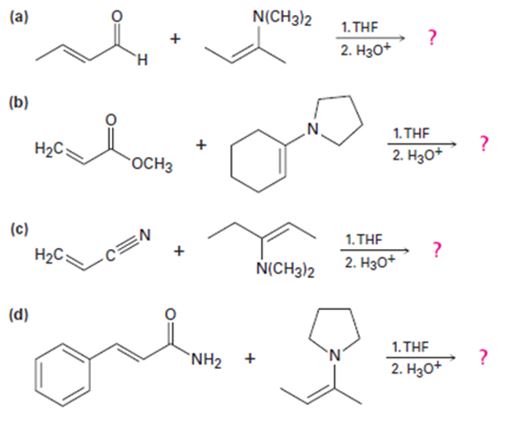
OWLv2 with Student Solutions Manual eBook, 4 terms (24 months) Printed Access Card for McMurry's Organic Chemistry, 9th
9th Edition
ISBN: 9781305671874
Author: John E. McMurry
Publisher: Cengage Learning
expand_more
expand_more
format_list_bulleted
Concept explainers
Textbook Question
Chapter 23.SE, Problem 31MP
Predict the product(s) and provide the mechanism for each reaction below.

Expert Solution & Answer
Trending nowThis is a popular solution!

Students have asked these similar questions
ΗΝ,
Draw Final Product
C
cyclohexanone
pH 4-5
Edit Enamine
H3O+
CH3CH2Br
THF, reflux
H
Edit Iminium Ion
How many hydrogen atoms are connected to the indicated carbon atom?
Identify the compound with the longest carbon - nitrogen bond.
O CH3CH2CH=NH
O CH3CH2NH2
CH3CH2C=N
CH3CH=NCH 3
The length of all the carbon-nitrogen bonds are the same
Chapter 23 Solutions
OWLv2 with Student Solutions Manual eBook, 4 terms (24 months) Printed Access Card for McMurry's Organic Chemistry, 9th
Ch. 23.1 - Prob. 1PCh. 23.1 - Prob. 2PCh. 23.3 - Prob. 3PCh. 23.3 - Prob. 4PCh. 23.4 - Prob. 5PCh. 23.4 - 1-Butanol is prepared commercially by a route that...Ch. 23.4 - Prob. 7PCh. 23.5 - Prob. 8PCh. 23.6 - Prob. 9PCh. 23.6 - What product would you Expect to obtain from base...
Ch. 23.7 - Show the products you would expect to obtain by...Ch. 23.7 - Prob. 12PCh. 23.8 - What product would you expect from the following...Ch. 23.9 - What product would you expect From the following...Ch. 23.9 - Prob. 15PCh. 23.10 - Prob. 16PCh. 23.10 - Prob. 17PCh. 23.10 - Prob. 18PCh. 23.11 - Prob. 19PCh. 23.11 - Show how you might use an enamine reaction to...Ch. 23.12 - Prob. 21PCh. 23.12 - How would you prepare the following compound using...Ch. 23.SE - Prob. 23VCCh. 23.SE - Prob. 24VCCh. 23.SE - Prob. 25VCCh. 23.SE - The following molecule was formed by a Robinson...Ch. 23.SE - Prob. 27MPCh. 23.SE - Prob. 28MPCh. 23.SE - Predict the product(s) and provide the mechanism...Ch. 23.SE - Predict the product(s) and provide the mechanism...Ch. 23.SE - Predict the product(s) and provide the mechanism...Ch. 23.SE - Knoevenagel condensation is a reaction involving...Ch. 23.SE - Azlactones are important starting materials used...Ch. 23.SE - Prob. 34MPCh. 23.SE - Isoleucine, another of the twenty amino acids...Ch. 23.SE - The first step in the citric acid cycle of food...Ch. 23.SE - Prob. 37MPCh. 23.SE - The Knoevenagel reaction is a carbonyl...Ch. 23.SE - The Darzens reaction invoIves a two-step,...Ch. 23.SE - The following reaction involves a hydrolysis...Ch. 23.SE - Prob. 41MPCh. 23.SE - Prob. 42MPCh. 23.SE - Prob. 43MPCh. 23.SE - Propose a mechanism for the following...Ch. 23.SE - Prob. 45MPCh. 23.SE - Prob. 46MPCh. 23.SE - Prob. 47MPCh. 23.SE - Prob. 48APCh. 23.SE - Prob. 49APCh. 23.SE - Prob. 50APCh. 23.SE - Prob. 51APCh. 23.SE - Prob. 52APCh. 23.SE - Prob. 53APCh. 23.SE - Prob. 54APCh. 23.SE - Prob. 55APCh. 23.SE - Prob. 56APCh. 23.SE - Prob. 57APCh. 23.SE - Prob. 58APCh. 23.SE - In the mixed Claisen reaction of cyclopentanone...Ch. 23.SE - Ethyl dimethylacetoacetate reacts instantly at...Ch. 23.SE - Prob. 61APCh. 23.SE - Prob. 62APCh. 23.SE - The so-called Wieland-Miescher ketone is a...Ch. 23.SE - Prob. 64APCh. 23.SE - Prob. 65APCh. 23.SE - Prob. 66APCh. 23.SE - What condensation products would you expect to...Ch. 23.SE - The following reactions are unlikely to provide...Ch. 23.SE - Fill in the missing reagents a-h in the following...Ch. 23.SE - Prob. 70APCh. 23.SE - Prob. 71APCh. 23.SE - Prob. 72APCh. 23.SE - Prob. 73AP
Knowledge Booster
Learn more about
Need a deep-dive on the concept behind this application? Look no further. Learn more about this topic, chemistry and related others by exploring similar questions and additional content below.Similar questions
- Identify any polar covalent bonds in epichlorohydrin with S+ and 8- symbols in the appropriate locations. Choose the correct answer below. Η H's+ 6Η Η Η Η Η Ηδ Η Ο Ο HH +Η Η +Η Η Η -8+ CIarrow_forwardH H:O::::H H H HH H::O:D:D:H HH HH H:O:D:D:H .. HH H:O:D:D:H H H Select the correct Lewis dot structure for the following compound: CH3CH2OHarrow_forwardRank the following compounds in order of decreasing boiling point. ннннн -С-С-Н . н-с- ННННН H ΗΤΗ НННН TTTĪ н-с-с-с-с-о-н НННН НН C' Н н-с-с-с-с-н НН || Ш НННН H-C-C-C-C-N-H ННННН IVarrow_forward
- Rank the following compounds in order of decreasing dipole moment. |>||>||| ||>|||>| |>|||>|| |||>||>| O ||>>||| H F H F H c=c || H c=c F F IIIarrow_forwardchoose the description that best describes the geometry for the following charged species ch3-arrow_forwardWhy isn't the ketone in this compound converted to an acetal or hemiacetal by the alcohol and acid?arrow_forward
- What is the approximate bond angle around the nitrogen atom? HNH H Harrow_forwardOH 1. NaOCH2CH3 Q 2. CH3CH2Br (1 equiv) H3O+ Select to Draw 1. NaOCH2 CH3 2. CH3Br (1 equiv) heat Select to Edit Select to Drawarrow_forwardComplete and balance the following half-reaction in acidic solution. Be sure to include the proper phases for all species within the reaction. S₂O₃²⁻(aq) → S₄O₆²⁻(aq)arrow_forward
- Q Select to Edit NH3 (CH3)2CHCI (1 equiv) AICI 3 Select to Draw cat. H2SO4 SO3 (1 equiv) HO SOCl2 pyridine Select to Edit >arrow_forwardComplete and balance the following half-reaction in basic solution. Be sure to include the proper phases for all species within the reaction. Zn(s) → Zn(OH)₄²⁻(aq)arrow_forwardb. ὋΗ CH3CH2OH H2SO4arrow_forward
arrow_back_ios
SEE MORE QUESTIONS
arrow_forward_ios
Recommended textbooks for you

 EBK A SMALL SCALE APPROACH TO ORGANIC LChemistryISBN:9781305446021Author:LampmanPublisher:CENGAGE LEARNING - CONSIGNMENT
EBK A SMALL SCALE APPROACH TO ORGANIC LChemistryISBN:9781305446021Author:LampmanPublisher:CENGAGE LEARNING - CONSIGNMENT Organic ChemistryChemistryISBN:9781305580350Author:William H. Brown, Brent L. Iverson, Eric Anslyn, Christopher S. FootePublisher:Cengage Learning
Organic ChemistryChemistryISBN:9781305580350Author:William H. Brown, Brent L. Iverson, Eric Anslyn, Christopher S. FootePublisher:Cengage Learning


EBK A SMALL SCALE APPROACH TO ORGANIC L
Chemistry
ISBN:9781305446021
Author:Lampman
Publisher:CENGAGE LEARNING - CONSIGNMENT

Organic Chemistry
Chemistry
ISBN:9781305580350
Author:William H. Brown, Brent L. Iverson, Eric Anslyn, Christopher S. Foote
Publisher:Cengage Learning
Coenzymes and cofactors; Author: CH15 SWAYAM Prabha IIT Madras;https://www.youtube.com/watch?v=bubY2Nm7hVM;License: Standard YouTube License, CC-BY
Aromaticity and Huckel's Rule; Author: Professor Dave Explains;https://www.youtube.com/watch?v=7-BguH4_WBQ;License: Standard Youtube License